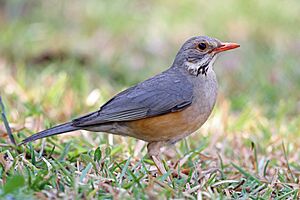Kurrichane thrush facts for kids
Quick facts for kids Kurrichane thrush |
|
|---|---|
 |
|
| Conservation status | |
| Scientific classification | |
| Genus: |
Turdus
|
| Species: |
libonyana
|
The Kurrichane thrush (Turdus libonyana) is a type of bird belonging to the thrush family, called Turdidae. You can find this bird in central and southern Africa. It naturally lives in dry savanna areas and woodlands, especially in miombo woodlands.
About the Kurrichane Thrush
The Kurrichane thrush was first described in 1836 by a zoologist named Andrew Smith. He studied a bird specimen found in the Transvaal region of South Africa.
The scientific name for this thrush, libonyana, comes from the Tswana language. It was actually the Tswana name for a different bird, the red-billed buffalo weaver. Scientists think this name was given by mistake, perhaps because both birds have a reddish beak. The common name, Kurrichane, comes from an old town in northern South Africa called Kaditshwene, where the first bird was found.
Where They Live: Distribution and Habitat
You can find the Kurrichane thrush in many countries across Africa. These include Angola, Botswana, Burundi, and the Democratic Republic of the Congo. They also live in Eswatini, Lesotho, Malawi, Mozambique, and Namibia. Other places they call home are South Africa, Tanzania, Zambia, and Zimbabwe.
These birds prefer dry areas with scattered trees, like savannas. They are often seen in woodlands, especially those with miombo trees.
What They Look Like: Description
The Kurrichane thrush is about 21 to 23 centimeters (8 to 9 inches) long. It usually weighs between 46 and 82 grams (1.6 to 2.9 ounces).
Its head, upper body, and chest are grey. The belly is whitish, and its sides have an orange color. The throat is white with black stripes along the sides. Its beak is orange, becoming a lighter yellow closer to its head. The color of its legs can be different shades. Both male and female Kurrichane thrushes look very similar.


